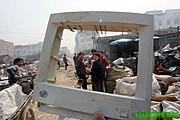Apple Greener, Nokia regains lead in electronics ranking
27 June 2007 (Ref:http://www.greenpeace.org/international/ new/ apple-greener-nokia-first-260607#)
Chinese e-waste scrap yard, as seen through a monitor you might have owned once.
The fourth edition of the Greenpeace Guide to Greener Electronics is out now. Apple moves up as a result of Steve Job’s “Greener Apple” pledge to phase out PVC and other chemicals from their product line. But Nokia is on top because they’ve already phased out PVC, and met or exceeded a wide set of benchmarks we’ve laid down to reduce the amount and toxicity of electronic waste piling up in Asia and Africa.
The electronics ranking guide has been our answer to getting the electronics industry to face up to the problem of e-waste. We want manufacturers to take responsibility for the unprotected child labourers who scavenge the mountains of cast-off gadgets created by our gizmo-loving ways.
We’ve been happily surprised at how quickly many corporations have risen to the competitive challenge. It’s especially rewarding to see more than a few CEOs openly vying for the top green spot, and challenging their competitors to adopt industry-wide policies to reduce the problem of e-waste.
In the current ranking, Dell and Chinese manufacturer Lenovo are tied for second place.
Dell scores top marks for reporting its current recycling rate based on sales 7 years ago, and for a strong global take-back policy for outdated gear.
Lenovo’s support for precautionary policies and legislation making producers responsible for their products at the end of their lifetime mean high marks for them. In the April version of the ranking Lenovo scored higher points for a global takeback policy. However our investigation of the implementation of this policy in practice reveals incomplete implementation.
Both Dell and Lenovo’s programmes are not available outside countries where they sell direct, and both do not provide information on their takeback policies everywhere that they should.
Sony-Ericsson and Samsung pull up third and fourth with limited recycling programmes in a few countries and good, but uneven, performance on other criteria for removing toxic chemicals.
This quarter’s ranking shows that 12 of the 14 companies assessed have now scored 5 or more out of ten: an industry-wide improvement in harmful chemicals and waste policies. Which company will be the first to get top marks in the guide? You can challenge the top computer makers to produce a greener computer right now.
Apple rises, Sony falls
Sony is the biggest loser in the race this edition, languishing at the bottom along with LGE, penalised for double standards on their waste policies.
Apple was the lowest-ranked electronics manufacturer in the last Greenpeace Guide to Greener Electronics, but makes the biggest jump this time, into 10th place, thanks to pressure from Apple fans around the world through the Green my Apple campaign.
Apple may start to rival other, greener companies if their much-awaited iPhone becomes the company’s first truly greener product. There’s no reason it can’t. Apple uses at least one of the same suppliers that currently provide Nokia, Sony-Ericsson, and other phone manufacturers with components free of PVC and brominated flame retardants.
“Clearly, companies are racing to produce greener products” says Iza Kruszewska, our Toxics Campaigner. “Steve Job’s latest commitment to eliminate toxics materials, moved Apple up the chart and they now face a challenge, with the iPhone, to meet customer expectations to be the environmental leader Apple-lovers want.”
More and more companies are providing information on products that are free from the worst chemicals. For example, as of March 2007, Panasonic has many examples of 100 percent PVC-free products on the market, including DVD players and recorders, home cinemas, video players, and now provides a list of products that are PVC-free. Meanwhile, Nokia, Sony Ericsson and Motorola are introducing increasing numbers of models that are also free from PVC and brominated flame retardants.
The Greenpeace Guide clearly demonstrates that companies are starting to act on their responsibility for taking back and recycling their own-branded waste, more and more extended voluntary programmes and providing information to customers on what to do with discarded electronics.
Take action
- Challenge the electronics industry to create a green computer. Who will be the first perfect 10?




